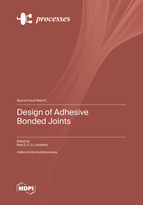Design of Adhesive Bonded Joints
A special issue of Processes (ISSN 2227-9717). This special issue belongs to the section "Manufacturing Processes and Systems".
Deadline for manuscript submissions: closed (30 June 2023) | Viewed by 21831
Special Issue Editor
Interests: advanced manufacturing systems; automation and robotics; industrial design
Special Issues, Collections and Topics in MDPI journals
Special Issue Information
Dear Colleagues,
The adhesive bonding technology has shown significant improvements over the past few decades, which enabled its application in many industries, such as aerospace, aeronautical and automotive. Nonetheless, new experimental techniques, as well as numerical models, are continuously being proposed in the scientific literature and applied in the industry, thus showing the relevance of this topic. Experimentally, new adhesives, material combinations, and joint geometries are continuously being explored, leading to innovative designs and improved solutions. On the other hand, analytical and numerical strength prediction models aim to accurately predict the joint’s behavior and, as a result, reduce the costs and expedite design. Constant evolution of these models is currently taking place, triggered by the need to model complex materials and loadings, with emphasis to numerical models, including improved fracture modelling by techniques, such as fracture mechanics, cohesive zone models, and the adaptation of recent techniques (including meshless methods). Fatigue and impact loadings are particularly challenging and have recently seen major advances. This Special Issue intends to bring together a significant number of good contributions in this area through high-quality original works in the adhesive joints field, subsequently promoting its dissemination through the open access system.
Prof. Dr. Raul D.S.G. Campilho
Guest Editor
Manuscript Submission Information
Manuscripts should be submitted online at www.mdpi.com by registering and logging in to this website. Once you are registered, click here to go to the submission form. Manuscripts can be submitted until the deadline. All submissions that pass pre-check are peer-reviewed. Accepted papers will be published continuously in the journal (as soon as accepted) and will be listed together on the special issue website. Research articles, review articles as well as short communications are invited. For planned papers, a title and short abstract (about 100 words) can be sent to the Editorial Office for announcement on this website.
Submitted manuscripts should not have been published previously, nor be under consideration for publication elsewhere (except conference proceedings papers). All manuscripts are thoroughly refereed through a single-blind peer-review process. A guide for authors and other relevant information for submission of manuscripts is available on the Instructions for Authors page. Processes is an international peer-reviewed open access monthly journal published by MDPI.
Please visit the Instructions for Authors page before submitting a manuscript. The Article Processing Charge (APC) for publication in this open access journal is 2400 CHF (Swiss Francs). Submitted papers should be well formatted and use good English. Authors may use MDPI's English editing service prior to publication or during author revisions.
Keywords
- adhesives
- adhesive joints
- adhesive joints characterization
- structural adhesives
- adhesive joint design
- experimental testing of adhesives
- analytical analysis of joint behavior
- numerical analysis of joint behavior
- strength prediction
- failure path prediction
- finite element method
- fracture mechanics
- cohesive zone models
- cohesive laws
- cohesive parameters
- damage mechanics
- extended finite element method
- meshless methods
- static load
- impact load
- fatigue load






